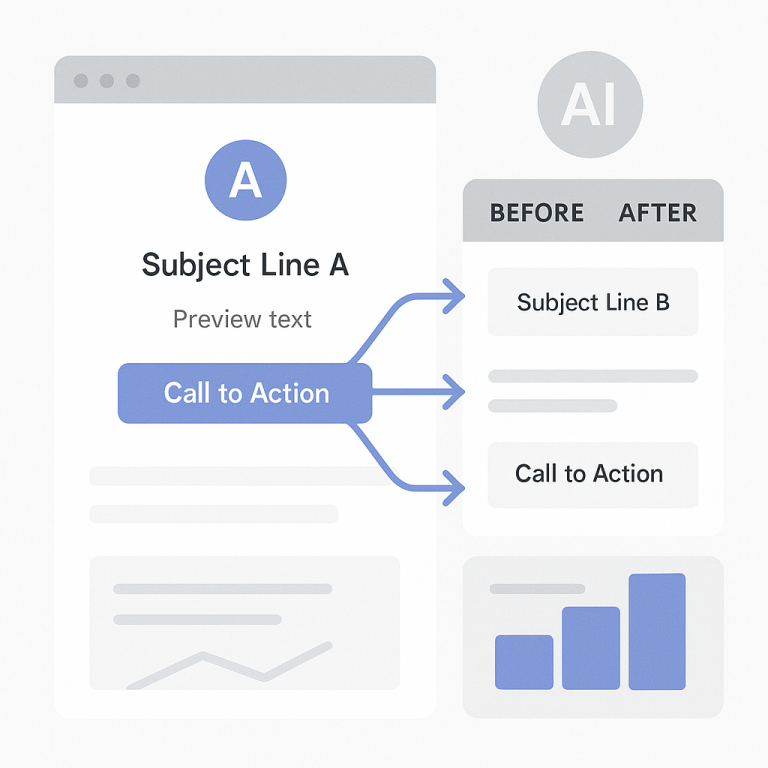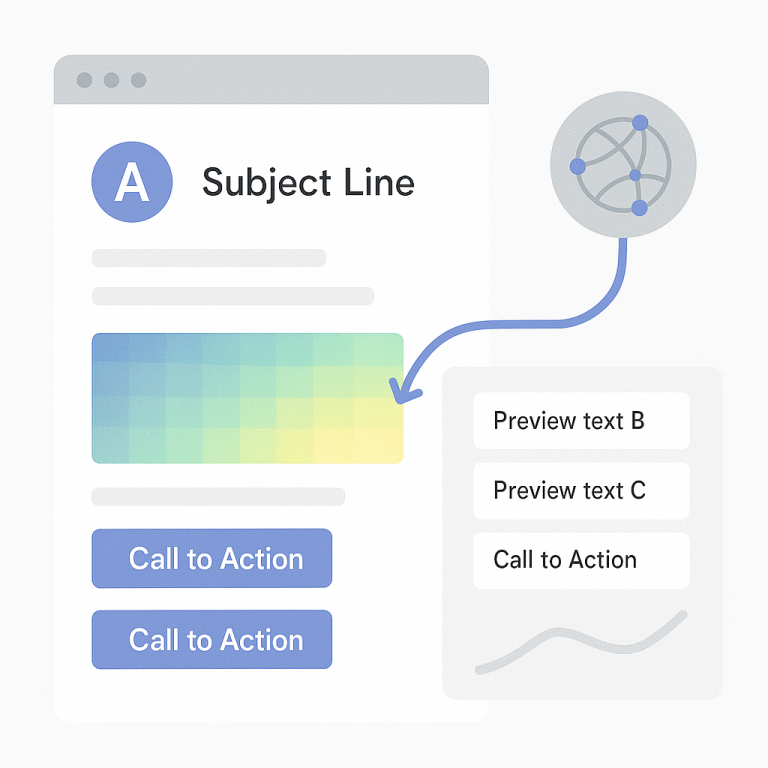Revolutionize Your Email Marketing with AI-Powered A/B Testing
Email marketing remains one of the most effective channels for reaching customers, with an impressive ROI of $36 for every $1 spent. Yet despite its effectiveness, many marketers still rely on outdated testing methods that limit their campaigns’ potential. The emergence of artificial intelligence has completely transformed how we approach email optimization, introducing dynamic capabilities that were unimaginable just a few years ago.
If your open rates have plateaued or your click-throughs seem stagnant, it might be time to explore how AI-fueled split testing can revolutionize your email performance—all while your campaign is still running.

The Evolution of Email A/B Testing
Remember the days of sending two versions of an email to small segments of your list, waiting for results, analyzing the winner, and only then sending to your remaining subscribers? That traditional approach, while better than no testing at all, now seems almost primitive compared to what’s possible with AI-powered solutions.
Limitations of Traditional A/B Testing
Conventional A/B testing methods have several inherent constraints that limit their effectiveness:
- Static Testing Cycles: Traditional methods require complete test cycles before implementation, creating a stop-start approach to optimization.
- Limited Variable Testing: You can typically only test one or two elements simultaneously without muddying your results.
- Delayed Insights: The time gap between testing and implementation means missed opportunities for immediate improvement.
- Statistical Challenges: Achieving statistical significance often requires large sample sizes, making testing impractical for businesses with smaller lists.
These limitations create a fragmented optimization process that can’t keep pace with today’s dynamic marketing environment. Just as you finalize one test, customer preferences and behaviors have already shifted.
The AI A/B Testing Advantage
AI-powered testing solutions fundamentally change the optimization approach by introducing:
- Real-time Optimization: Adjustments happen automatically while your campaign is still running.
- Multivariate Capabilities: Test dozens of variables simultaneously without losing analytic clarity.
- Pattern Recognition: Machine learning identifies subtle performance patterns that human analysts might miss.
- Automated Implementation: Winning variations deploy automatically without manual intervention.
This transition from static to dynamic testing represents a fundamental shift in how marketers approach email optimization. As automated AI templates become increasingly sophisticated, the potential for hands-off optimization continues to expand.
Dynamic Subject Line Optimization with AI
Your subject line is the gatekeeper of your email’s success—no matter how brilliant your content, it’s worthless if the email remains unopened. AI excels at optimizing this crucial element through continuous performance analysis and adjustment.
How AI Analyzes Subject Line Performance
Modern AI doesn’t just count opens; it conducts sophisticated analysis of multiple factors:
- Linguistic Pattern Analysis: Natural language processing identifies word combinations, sentence structures, and phrases that drive higher engagement.
- Sentiment Evaluation: AI measures the emotional impact of different tones and approaches, from urgency to curiosity to FOMO.
- Personalization Assessment: Systems analyze when and how personalization elements increase effectiveness.
- Contextual Optimization: Performance is evaluated based on time of delivery, device type, recipient history, and other contextual factors.
These analytical capabilities allow AI to make nuanced decisions about subject line performance that go far beyond simplistic open rate comparisons.
Implementing Dynamic Subject Line Testing
Setting up effective AI-powered subject line optimization involves several key considerations:
- Create 5-10 initial subject line variations representing different approaches and tones
- Define clear success metrics (open rate, but potentially also downstream metrics)
- Determine appropriate sample sizes for initial testing phases
- Configure auto-optimization rules (e.g., when to shift traffic to winning variations)
- Set guardrails for AI decision-making to maintain brand voice consistency
The key advantage here is that optimization happens continuously, not just at predetermined intervals, maximizing every opportunity for improvement.
Case Study: Subject Line Optimization Results
Metric | Before AI Optimization | After AI Optimization | Improvement |
Average Open Rate | 18.5% | 27.3% | +47.6% |
Click-Through Rate | 2.1% | 3.8% | +81.0% |
Revenue Per Email | $0.11 | $0.19 | +72.7% |
In this example from an e-commerce retailer, dynamic subject line optimization led to significant performance improvements within the same campaign. The AI system identified that question-based subject lines with specific product mentions consistently outperformed alternative approaches, and automatically shifted traffic to these variations.
AI-Powered Preview Text Optimization
Preview text—the snippet of content visible in the inbox before opening—works hand-in-hand with your subject line but is often overlooked in testing strategies. AI optimization brings this powerful element into focus.
Preview Text as a Conversion Tool
Effective preview text serves several critical functions:
- Expands on the subject line’s promise without redundancy
- Creates a curiosity gap 🛈 that motivates opens
- Communicates additional value beyond what’s mentioned in the subject
- Overcomes potential objections preemptively
The challenge lies in optimizing within strict character limitations while maintaining coherence with the subject line—a perfect task for AI’s pattern-recognition capabilities.

Evolving CTA Optimization Using AI
While getting subscribers to open your email is crucial, conversion ultimately depends on click-through and action. AI-powered CTA optimization ensures your call-to-action elements evolve to maximize performance throughout your campaign.
CTA Elements Ripe for Dynamic Testing
Modern AI testing platforms can simultaneously evaluate numerous CTA variables:
- Button Text: Word choice, length, verb usage, and personalization
- Design Elements: Color, size, shape, border, and placement
- Supporting Content: Text above/below the CTA, imagery, and social proof elements
- Mobile Optimization: Button size and positioning optimized differently for mobile versus desktop users
The advantage of AI-powered optimization is its ability to test these elements in combination, rather than in isolation, identifying the perfect symphony of elements that drive conversion.
Implementing Mid-Campaign CTA Evolution
Effective implementation requires thoughtful setup:
- Configure your email template with dynamic content zones for CTAs
- Generate multiple CTA variations (at least 5-7) with meaningful differences
- Define primary metrics (typically click-through) and secondary goals (conversion, revenue)
- Set audience segment parameters to ensure relevant learning
- Establish rules for when and how the system should implement changes
The beauty of AI-powered optimization is that it doesn’t just identify a single winner—it can identify which CTA variations work best for different audience segments, times of day, or devices, implementing targeted variations accordingly.
Case Study: CTA Optimization Impact
A B2B software company implemented AI-powered CTA testing and saw remarkable results:
- 44% increase in click-through rate
- 28% higher demo request conversion rate
- 37% reduction in cost-per-acquisition
The AI system discovered that for technical decision-makers, specific feature-focused CTAs outperformed general value statements, while the opposite was true for executive-level recipients. This insight allowed for automatic segmentation and targeting that would have been difficult to identify through conventional testing.
Implementing AI-Fueled Email Split Testing
Moving from concept to implementation requires the right technology stack and methodical approach. Here’s how to get started with AI-powered email testing.
Essential Technology Stack Components
Building an effective AI testing capability requires several key components:
Component | Function | Implementation Considerations |
AI-Capable ESP | Email delivery with dynamic content capabilities | Look for native AI features or robust API for third-party integration |
Optimization Platform | AI algorithm management and decision-making | Should support multi-armed bandit or similar learning algorithms |
Analytics Solution | Performance tracking and reporting | Must integrate with both ESP and optimization platform |
Content Generation Tools | Creation of multiple test variations | Consider AI-assisted content generation for testing at scale |
When evaluating solutions, prioritize platforms with seamless integration capabilities and proven track records in your industry or use case. The GIBION AI platform offers an integrated solution for teams looking to implement advanced email optimization with minimal technical overhead.
Setting Up Your First Dynamic Campaign
Follow these steps to launch your first AI-optimized email campaign:
- Create Diverse Variants: Develop 8-10 variations of each element you want to test, ensuring meaningful differences between them
- Define Clear Goals: Configure primary optimization metrics (e.g., open rate for subject lines, CTR for body content)
- Set Learning Parameters: Configure how the system balances exploration (testing new variations) versus exploitation (leveraging known winners)
- Establish Guardrails: Define minimum performance thresholds and brand guidelines to prevent problematic variations
- Launch With Sufficient Volume: Ensure your campaign has enough recipients to gather statistically meaningful data
Start with a campaign where you have sufficient volume and where small improvements would yield meaningful business impact. This creates the ideal learning environment while demonstrating the value of AI optimization.
Measuring Success and Continuous Improvement
Effective measurement goes beyond simple campaign metrics:
- Comparative Analysis: Measure against similar non-AI-optimized campaigns for true impact assessment
- Full-Funnel Tracking: Monitor downstream conversion metrics, not just immediate email engagement
- Learning Documentation: Catalog insights about what works for future campaign planning
- Cross-Campaign Application: Apply learnings systematically across all email initiatives
The true power of AI-powered testing emerges over time as the system builds an increasingly sophisticated understanding of your audience’s preferences and behaviors. Each campaign becomes not just an opportunity for immediate optimization but a data-gathering exercise that improves future performance.
Future Trends in AI Email Optimization
As AI capabilities continue to advance, we’re seeing exciting new frontiers in email optimization that will further transform marketing performance.
Predictive Content Optimization
The next wave of innovation includes:
- Generative AI Content: Systems that automatically create multiple content variations based on performance patterns
- Predictive Engagement Models: AI that anticipates which content will resonate before sending
- Individual Preference Learning: Optimization at the individual recipient level, not just segment level
- Cross-Channel Integration: Email optimization that considers and influences performance in other channels
These innovations will shift email optimization from reactive (based on campaign performance) to proactive (based on predicted performance), dramatically increasing efficiency and effectiveness.
Ethical Considerations and Privacy Compliance
As AI optimization capabilities grow more sophisticated, so do the ethical considerations:
- Transparency Requirements: Being open with subscribers about optimization practices
- Privacy-First Approaches: Developing techniques that balance personalization with privacy
- Preference Management: Allowing subscribers to control their optimization experience
- Regulatory Navigation: Ensuring compliance with evolving privacy regulations worldwide
Organizations that can balance optimization effectiveness with ethical considerations will build the trust necessary for long-term success in an increasingly privacy-conscious environment.
Conclusion: The Optimization Advantage
AI-fueled split testing represents a fundamental shift in email marketing—from periodic, manual optimization to continuous, automated performance improvement. By embracing these capabilities now, marketers can create significant competitive advantages while building deeper understandings of what truly resonates with their audiences.
The organizations seeing the greatest success with AI optimization aren’t treating it as a one-time implementation but as an ongoing capability that continuously refines their understanding of customer preferences and behaviors. This learning compounds over time, creating an expanding performance gap between AI adopters and those still relying on traditional methods.
Is your organization ready to revolutionize its email marketing through AI-powered dynamic optimization? The technology is mature, accessible, and delivering measurable results across industries. The only question is how quickly you’ll capitalize on the opportunity.




